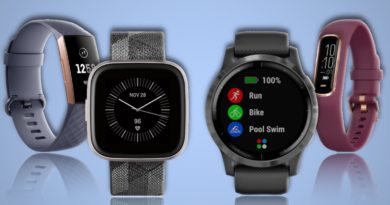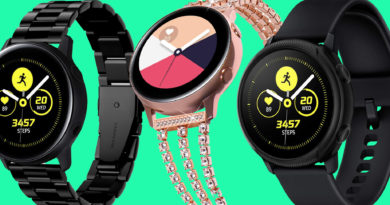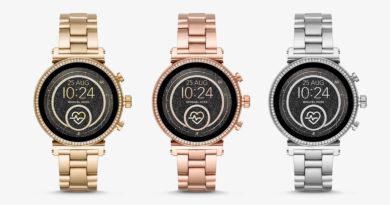Fitbit Versa 2 v Fitbit Versa: Six differences between the smartwatches
Fitbit’s Versa 2 is a big device for the company – after the lacklustre sales of the Versa Lite, it’s in need of a successful launch.
The Versa 2 is, obviously, an update of the Fitbit Versa, Fitbit’s foray into the world of smartwatches rather than pure fitness trackers. We liked that watch plenty when we reviewed it back in 2018.
Hand-on reviews: Fitbit Versa 2 review | Fitbit Versa reviewIf you’re thinking of picking up one of the two models but aren’t sure which one to go with, we’re here to help. The two devices have some similarities, needless to say, but also pack some important differences. We’ve collated all of the most telling distinctions, which you’ll find detailed below, after a quick table to summarize the two models’ specs for you.
Fitbit Versa 2Fitbit VersaDisplay
AMOLED
1.34-inch, 300×300 LCD
Size
TBC
11.2mm depth
Heart Rate Sensor
PPG Optical sensor
PPG Optical sensor
GPS
No GPS
No GPS
Battery Life
Five days
Four days
Price at release
From $199.95
$199
Fitbit Versa 2 or Fitbit Versa: What are the differences?You’ll find full details of specs and our respective experiences using each of these smartwatches in our reviews for them, but here you’ll find some direct comparisons of the two. We’ve gone through to find six differences between the Versa 2 and Versa that could matter to you. 1. DisplayThe original Fitbit Versa has an impressive display, with good depth of color and clear readability. It’s an LCD display with a resolution of 300×300, and no slouch at all.
However, Fitbit has given it a proper upgrade for the Versa 2. Firstly, it’s now using an AMOLED display, which offers slightly deeper blacks and even sharper details. The display is also slightly bigger (although by exactly how much isn’t yet concrete, before the Versa 2’s launch in mid-September), and every little bit counts when it comes to wrist real estate.
If you’re keen to make sure you’ve got the best display possible, the Versa 2 is the choice for you.
2. FeaturesAs far as features are concerned, the Versa 2 packs a first for Fitbit, also in the display stakes. The new model boasts the first ever Fitbit display that can be always-on, needing no wrist-raising or button-pressing to be viewed.
This obviously hits battery life pretty hard, shortening it from five days to more like two, but it’s still a pretty attractive feature that the original Versa can’t match.
Both watches share a range of other features, including Fitbit Pay, and the full range of fitness tracking abilities. This means they can track your workouts, detect activity and monitor your heart rate with their optical sensors. They’re also both swim-proof to a depth of 50 meters. This means that regardless which Versa model you choose, you’ll get getting access to impressive and comprehensive fitness tracking.
3. AlexaAnother big difference between the Versa 2 and Versa serves to emphasize the “smart” bit of their smartwatch status. The Versa 2 comes with Alexa, Amazon’s smart assistant, built in.
The newer watch packs a small microphone hole on its side, to allow you to talk to Alexa – activated by holding down the button to the side of the display. The watch doesn’t have a speaker, so responses will be viewable on the screen. You’ll be able to ask the assistant to set reminders, answer queries, or obey commands – say, if you’ve got a smart home set up, to turn the lights on.
Again, needless to say, this isn’t present on the original Versa, so if you’re keen to step up your interaction with Alexa the newer model has a clear advantage.
4. DesignIn terms of the design of the watches’ looks, there’s much less to pick between them. Fitbit may have eked some extra space for the screen out of the watch’s frame, but the two models look really similar side-by-side. However, in the actual wearing, the Versa 2 is a lot flatter to the wrist as a result of changes to the optical sensor, first ushered in by the Versa Lite Edition.
This means that if you’re particularly interested in the look of the watch you’ve got less to worry about. With the range of interchangeable straps available for either device, you’ll have plenty of customization options, and either model should look similar on your wrist or under a shirt cuff.
5. Battery lifeThe Versa 2 scores another win against its predecessor when it comes to battery life, always an important consideration when choosing a smartwatch.
The original Versa could be expected to last for four days or more before a charge was needed. For the Versa 2, this estimate has been upped to five days or more, meaning you could get through a whole work week before you have to pop it on its charging cradle. As mentioned, this will decrease a lot if you use the always-on display, but using similar features to the original Versa will underscore the increased life.
6. PriceThe Fitbit Versa 2 is launching with a price of
$199.95 for the standard edition of the smartwatch, with a special edition available for $229.95, including three months of
Fitbit Premium, Fitbit’s new subscription service.
This is a very similar price to that with which the Versa launched, but since that device is older now you can find it for slightly less from various retailers, often as low as $169.95. This means that if you’re particularly keen on sticking to a lower budget, you could save $30 by opting for the older model.Fitbit Versa 2 or Fitbit Versa: Which smartwatch is best?As always with comparisons between devices, which is better for you depends slightly on your priorities. The Versa 2 brings some nice upgrades over the Versa, especially if you’re either a practised user of Alexa or are happy to get to know the smart assistant.
The nicer display and boosted battery life are also worthwhile improvements. The Fitbit Versa was and remains a great smartwatch, though, and if you’d prefer to stay closer to the $150 mark it may make sense to pick it up.
Both smartwatches have a similar software experience, with the Fitbit app shared by them, and most of the app updates and compatibility brought to the Versa 2 should also arrive for the Versa in due course.
However, at full price the improvements brought to the table by the Versa 2 seem worth the small bump in cost, and we’d ultimately recommend the newer model to most users. As we get more time with the Versa 2, though, we’ll continue to update this comparison with our experiences and further details.


